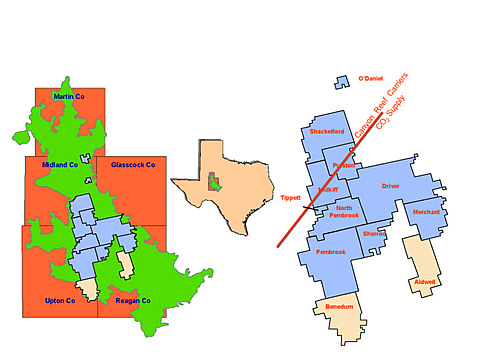The naturally fractured Spraberry Trend Area is one of the largest reservoirs in the United States and is the largest reservoir in areal extent in the world. Production from Spraberry sands is found over a 2,500 square mile area, and Spraberry reservoirs can be found in an eight-county area in west Texas. Over 150 operators produce 65,000 barrels of oil per day from the Spraberry Trend area from more than 9,000 production wells. Recovery is poor, on the order of 7-10% due to the profoundly complicated nature of the reservoir, yet billions of barrels of hydrocarbons remain. NETL estimates over 15% of remaining reserves in domestic Class III reservoirs are in Spraberry Trend Area reservoirs. This tremendous domestic asset is a prime example of an endangered hydrocarbon resource in need of immediate technological advancements before thousands of wells are permanently abandoned.
Project Results
The major achievements of the project are 1) providing an integrated solution to technological, regulatory, and data constraints in the Spraberry Trend area; 2) completing a field demonstration via technological innovations; 3) determining that converted production wells are not suitable for injection due to previous fracture treatments; and 4) stimulating investment in further waterflood projects in the Spraberry Trend area.
Benefits
Spraberry was once deemed the "largest uneconomic field in the world." As the major oil companies migrate to larger international projects with higher potential returns, mid-size and small oil companies have resumed operating old fields in the U.S. These companies usually increase production in marginal fields but lack access to developments in technology that could perhaps be the difference between a plugged and abandoned (P&A) and a producing well. Spraberry wells are known for their longevity; however, many have been P&A, with many more scheduled in the future. The average well in the Spraberry Trend area produces 7 barrels of oil per day, thus it is obvious there exists a tremendous number of wellbores that will be P&A in the near future. This loss of wellbores in a field containing such a large amount of remaining oil without thoroughly investigating water injection is not in the best interest of maintaining healthy domestic production and hence is contrary to the Nation's energy security interests. If only a fraction of the Spraberry wells could increase production, the tremendous scale of the reservoir would result in a highly successful endeavor for DOE and the PUMP program.
Project Summary
The project calls for researchers to:
- Integrate solutions to technological, regulatory, and data constraints by:
- Reconstructing Shackelford and Germania injection/production data.
- Providing a new reservoir surveillance software, Integrated Field Data Management software (IFDM).
- Acquiring and managing 40 years of production and injection data using Oil Field Manager (OFM) and IFDM.
- Conduct a field demonstration of technological innovations by:
- Identifying casing leaks in San Andres disposal wells that eventually water out Spraberry producers or damage casing, resulting in premature abandonment.
- Evaluating the performance of past waterflood pilots in order to reach the stage of development of management practices that eventually could unlock the key to successful water injection in Spraberry formations.
- Refining Germania subsurface maps for 1U and 5U oil-saturated intervals using an analog field and old cased-hole neutron data.
- Improving an understanding of fluid movement, waterflood recovery mechanisms, and sweep efficiency.
- Proposing a new waterflood technique by aligning injection wells along the fracture trend with production wells.
- Providing complete production surveillance information.
- Evaluating pilot flood performance and proposing pilot modification.
- Proposing several field tests in order to acquire more important information of the flood performance.
- Proposing a new strategy based on response and development of expansion plans.
- Improving confidence in the merits of water injection.






